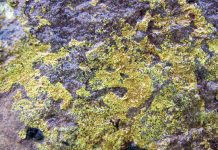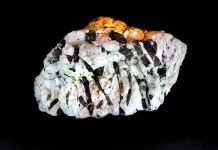
By Jim Brace-Thompson
Do you have a mineral labeled “glauberite” in your collection? I do, but I recently learned that it may not be what it seems! True glauberite is sodium calcium sulfate, Na2Ca(SO4)2. It grows soft (Mohs 2.5-3), nicely formed, bipyramidal tabular crystals often as doubly-terminated blades or in flower-like clusters that may be white, gray, buff or light yellow with a glassy luster.
Glauberite’s Pseudomorph Profile

However, glauberite is a fairly rare mineral because it tends to be unstable. It forms in clay and/or evaporate deposits such as dry lake beds in desert environments. It is both highly soluble and efflorescent, meaning that as it dries, it crumbles into a powder and may easily be dissolved away. Thus, what is often labeled “glauberite” by mineral dealers is more often a pseudomorph.
As glauberite crystals dissolve or crumble, they may be altered or replaced by more stable minerals such as gypsum or calcite that take the form of the original glauberite crystals. It is these pseudomorphs (including those in my own collection) that you often see labeled as “glauberite”.
Misidentified Malachite
In addition, you may run across big, showy green crystal clusters labeled “malachite pseudomorphs after glauberite” from Camp Verde, Arizona. Buyer beware! Such crystals are indeed from Camp Verde (where glauberite pseudomorphs may be collected by the bucketful), but they are neither malachite nor natural in color. Instead, these are calcite pseudomorphs that have been artificially dyed green by unscrupulous dealers who have soaked crystals in copper sulfate solutions.
Glauberite is found in many places worldwide, often in desert climates, as in Kenya, Chile, India, Spain, Australia, and the southwestern U.S. However, it is also found in areas that today are by no means desert environments, including Russia, Austria, and Germany. In fact, it was named in 1808 after the German alchemist Johann Rudolf Glauber, who extracted “Glauber’s salts” in 1625.

















